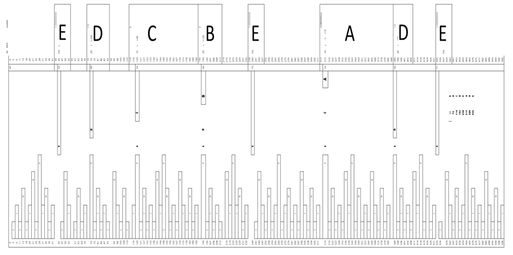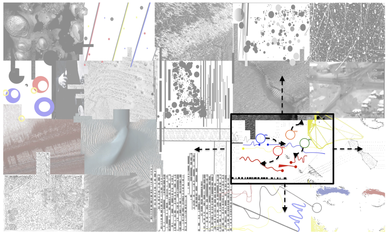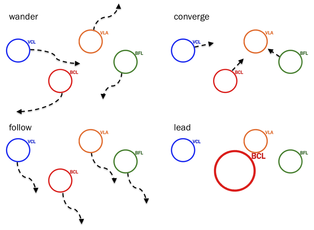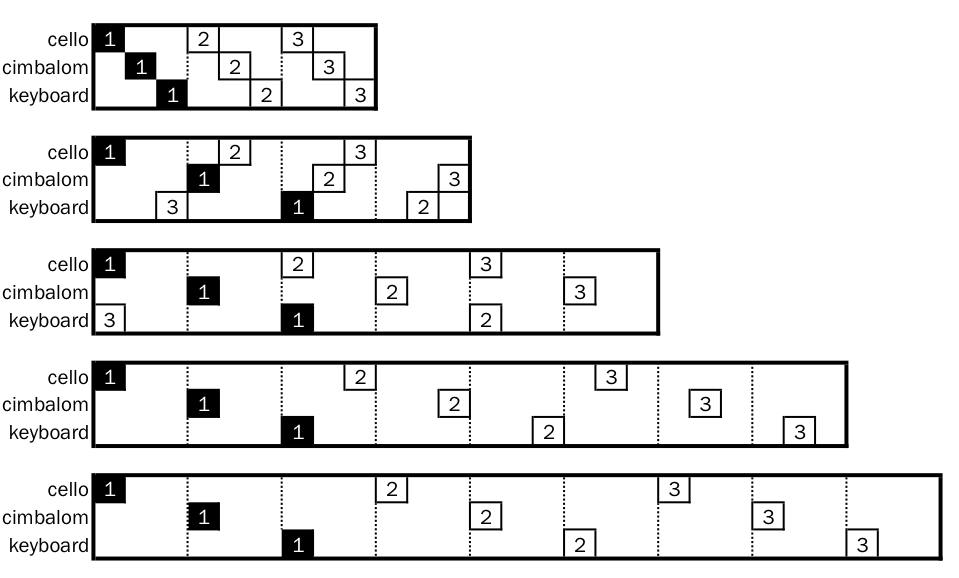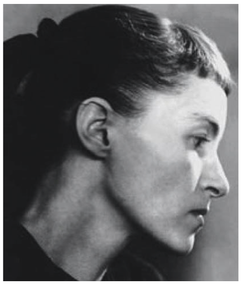2011
121 Reconstruction of a shifting path [2011] disklavier 9m
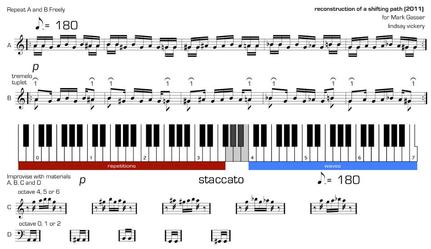
Reconstruction of a Shifting Path places the Yamaha Disklavier in the dual role of performance instrument and electronic trigger. The score, presented to the performer on screen alternates between traditionally notated sections and sections in which materials to explore through improvisation are presented. In both cases a “triggering map” of the keyboard is, which is altered from section to section, is also displayed to the pianist. The picture to the left shows a screenshot of one section of the work.
One potential problem of indeterminate “open” approach is that it is possible for one particular instantiation to be less satisfying than another. Reconstruction of a Shifting Path tackles this issue by fixing the positions of the synchronous materials while leaving the interstitial spaces between them open to more improvisatory exploration.
The temporal structure of Reconstruction of a Shifting Path is derived from recursively applying the golden section to the duration of the work, and successive, nested, layers of substructure.
One potential problem of indeterminate “open” approach is that it is possible for one particular instantiation to be less satisfying than another. Reconstruction of a Shifting Path tackles this issue by fixing the positions of the synchronous materials while leaving the interstitial spaces between them open to more improvisatory exploration.
The temporal structure of Reconstruction of a Shifting Path is derived from recursively applying the golden section to the duration of the work, and successive, nested, layers of substructure.
|
The picture on the right shows the structure of Reconstruction of a Shifting Path, where the golden section of the work is marked by section A, the golden section of the passage from the beginning until A is marked by section B, and so on until the fifth level of substructure. Crucial notated formal events are presented to the pianist at these pivotal points. Between these points, the computer indeterminately choses improvisatory material for the pianist to explore according to cues which are determined by proportions of the sixth to tenth level of “golden ratio” substructure.
|
Performances:
20111027 Mark Gasser, The Mechanical Piano, WAAPA Auditorium, Perth
20110916 Mark Gasser, Piano Tapestry, Totally Huge New Music Festival 2011, State Theatre Centre, Perth
20111027 Mark Gasser, The Mechanical Piano, WAAPA Auditorium, Perth
20110916 Mark Gasser, Piano Tapestry, Totally Huge New Music Festival 2011, State Theatre Centre, Perth
120 Questions Written on Sheets of Glass [2011] instrument, disklavier and electronics ~8m
In questions written on sheets of glass the soloist’s performance is analysed and then rendered in a number of contrasting ways on a Yamaha Disklavier. The work was inspired in part by the “speaking piano” of German composer Peter Ablinger (Ablinger 2009), a process by which spoken text is analysed into its component partials, amplitudes and durations and the “resynthesised” by performing it via MIDI on a computer controlled piano. Likewise, questions written on sheets of glass makes a realtime analysis of the soloists performance and then employs elements of pitch, duration and amplitude information derived from the performer to generate a range of textures on a Disklavier. Like partikulator, this permutation of textures process is open ended and defined only by pre-specifying the duration of the work.
In questions written on sheets of glass the soloist’s performance is analysed and then rendered in a number of contrasting ways on a Yamaha Disklavier. The work was inspired in part by the “speaking piano” of German composer Peter Ablinger (Ablinger 2009), a process by which spoken text is analysed into its component partials, amplitudes and durations and the “resynthesised” by performing it via MIDI on a computer controlled piano. Likewise, questions written on sheets of glass makes a realtime analysis of the soloists performance and then employs elements of pitch, duration and amplitude information derived from the performer to generate a range of textures on a Disklavier. Like partikulator, this permutation of textures process is open ended and defined only by pre-specifying the duration of the work.
Performances:
20111027 Lindsay Vickery, The Mechanical Piano, WAAPA Auditorium, Perth
20111027 Lindsay Vickery, The Mechanical Piano, WAAPA Auditorium, Perth
119 The Talking Board [2011] (with Cat Hope) four instruments and electronics 8m
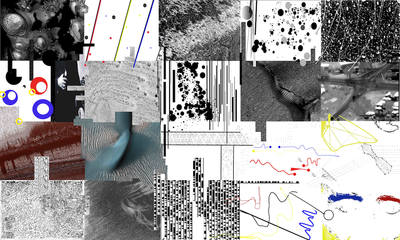
The Talking Board was created in collaboration with composer Cat Hope. The work utilises a graphical score-collage of twenty images provided by Hope and myself, (to the left). The four performers realize the work by interpreting the components of the score that are framed by a “planchet”: a circle, colour coded to correspond to each instrument, that also moves freely around the score. The term is taken from the designation of the heart-shaped piece of wood used on a Ouija Board (or Talking Board) to indicate the supposed responses of “spirits”. The graphical score is also continuously repositioned during the performance, moving smoothly in the vertical and horizontal dimensions and also jumping to particular new positions. Below is a representation of the relationship between the mobile score and the visible score that appears on the performer’s screen (shown here as the opaque rectangle in the lower right-hand corner). The visible portion of the mobile screen is continuously repositioned during the performance.
|
I programmed the trajectories of the planchets so that their movements are indeterminate, but permutate between a range of contrasting behaviors: wander – in which the movement of the four planchets are completely independent; follow – in which three planchets mirror the trajectory of the remaining planchet; and converge in which three planchets converge on the (moving) position of the remaining planchet. In addition to these behaviours, each planchet is programmed to grow in size at indeterminate points in the performance, indicating that the corresponding performer should take a more soloistic role. These behaviours are illustrated below.
|
|
The movement of the score and the behaviours of the planchets define the formal structure of the work. Importantly, since the score employs asemic graphical notation, the players are left to interpret the symbols how they will. The result of this circumstance is that, in a live performance, players tend to move towards a consensus in terms of means of interpretation, creating a gradual transformation towards greater parametrical unity of texture in each new notational environment presented by the computer. Therefore, the structural outcome of any particular instantiation of the work is extremely indeterminate, relying as it does upon indeterminate trajectories both of the score and the planchets, as well as each performer’s interpretations of and group interactions to, the large number and diversity of the graphical images.
|
|
|
|
Performances:
20110915 Decibel Camera Obscura, Totally Huge New Music Festival, Perth Institute of Contemporary Arts, Perth
20120204 Decibel, Il Suono Dei Sol, Goethe Institut, Palermo
20120127 Decibel, Australian Music, SWR Tage für Neue Musik, Rottenberg , Germany
20120191 Decibel, Australian Music WABE, Berlin
20161213 Decibel: iCLA Yamanashi University, Japan
20110915 Decibel Camera Obscura, Totally Huge New Music Festival, Perth Institute of Contemporary Arts, Perth
20120204 Decibel, Il Suono Dei Sol, Goethe Institut, Palermo
20120127 Decibel, Australian Music, SWR Tage für Neue Musik, Rottenberg , Germany
20120191 Decibel, Australian Music WABE, Berlin
20161213 Decibel: iCLA Yamanashi University, Japan
118 hunting pack [2011] cello, cimbalom, keyboard and electronics 7m
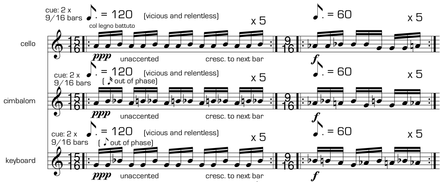
The formal divisions in Hunting Pack are principally marked by changes in the temporal relationship between the three players. Sections two and three cast the three instruments in different, but proportionally related tempi: Section Three at 90/120/210 bpm with the ratios 3/4/7 and Section Two at 60/80/100 bpm with the ratios 3/4/5.
The range of approaches to polytemporality explored in each section of the work are:
|
Section one simultaneously accelerates or decelerates the three instruments at different rates: Cello from 4.25 to 60 bpm, Cimbalom from 9.5 to 80 bpm and Cimbalom from 16 to 100 bpm. In section four the three instruments accelerate and decelerate continuously between a maximum tempo of tempi 360 and a minimum tempo of 72 bpm. The variations in the pattern of tempo changes between the instruments are as follows.
|
|
Finally, the opening section explores micro-rhythm through the displacement of each instrument by a small durational value. The click-tracks synchronizing the players are displaced by small values allowing the performance of extremely rapid and intricate patterns. When combined with the small intervallic compass between the instruments in the section of a major third, this technique results in perceptual fusion due to Temporal Continuity and Pitch Proximity of the three parts. This process is similar to the fusion of the two manuals of the harpsichord into a single perceptual unit in Ligeti’s Continuum (1968) as described by Cambouropoulos. The displacement of the down beats of each performer is illustrated in the graphic to the left.
|
Performances:
20110620 Decibel, Pretty Things Perth Institute of Contemporary Arts, Perth
20110620 Decibel, Pretty Things Perth Institute of Contemporary Arts, Perth
117 partikulator [2011] bass clarinet and electronics 9m
Partikulator was created for an improvising soloist. Partikulator combines the permutative audio processing methodology of Echo-Transform with the desire to stimulate an improvisation through unexpected sonic outcomes explored in Splice. It evolved from similar modules that I had devised for improvised noise performances in the group Candied Limbs with bass player Cat Hope. The structure consists of 27 combinations of audio processing techniques, each of a different duration, that are permutated, appearing only once in any performance of the work. Unlike Splice and Echo Transform the soloist is instructed which of the combinations of audio processing techniques are in play, allowing for interaction on a visual basis.
|
Performances:
20110512 Lindsay Vickery, Sound Spectrum, The Velvet Lounge, Perth |
|
116 Night Fragments [2011]mezzo-soprano, alto flute, clarinet, cello, keyboard and electronics 17m
|
Night Fragments is a multi-movement work responding to a text. The texts are taken from Belgian Surrealist author, poet and literary historian Françilon Daniels’ posthumously published Journaux Intimes (Gallimard). According to the author they were created using a variant of the Surrealist paranoiac-critical method that she described as "écriture de sommeil": noting thoughts at the twilight between sleep and wakefulness. The handwritten texts were arranged unusually on the page, sometimes overlapping with one another. It is not known whether they were intended to be calligrams – visual poems - or if this was the result of the author “transcribing” them in the dark. The work was in part an exploration of the possibilities afforded by the computer coordinated performance model, which I had first employed in Transit of Venus. In Night Fragments, the segmented screen-score, audio processing, spatialisation, mixing and temporal coordination through independent click-tracks, is centralised in the computer, allowing for the exploitation of convergences of the formal implications of these elements to the millisecond. Night Fragments was written for Caitlin Cassidy and Decibel.
|
|
NIGHT FRAGMENTS (1947-60)
1. [ some other world or time ] words feverish words some other world or time writing without seeing what is written a black and white jigsaw puzzle in the shape of a person I can’t find the head a tiny burning star just fragments now not here not now words serve a purpose they have a life of their own lamps without light almost gone there are eyes that see in the dark and other eyes that remain closed in the dark something left to say but it's too late 2. [ invisible net ] the birds flow up towards their invisible net a broken wing beating on the ground 3. [ faded back into static ] all of this everything you said is gone evaporated in a sea of words like a radio the story ended there a transmission stumbled upon by chance faded back into static 4. [ red wolf ] it is a red wolf lying on the embers of a fire the wolf walks out onto a field which is covered with snow 5. [ a man stands on the wing ] a man stands on the wing in a suit and with a briefcase |
6. [ resting underwater ]
riding through a flood or a small lake the water is clear as the sea rising up I can see the horses resting below they are resting under the water I am resting under the water 7. [ slowly filling with keys ] one by one the nurse places keys in my mouth The doctor says "You’ll have to swallow them” I swallow my body slowly filling with keys the key falls down the door opens but they are gone 8. [ the surface remains unmoved ] travelling down a thin channel it is high in the air the sea is on the left far below there are masts on the shore with fish streaming from them swimming in the breeze walk down many flights of wooden stairs to the edge of the sea I drop a book a white rectangle into the clear ocean I can still see it a tide though the surface remains unmoved as she falls she transforms into hundreds of tiny sea shells shining like mother of pearl they burrow down into the sand 9. [ night flowers ] the night flowers do not open their eyes even under the forest moon words without mouths |
Performances:
20110328 Decibel, A Voice from a Dark Place, PICA, Perth
20110328 Decibel, A Voice from a Dark Place, PICA, Perth

